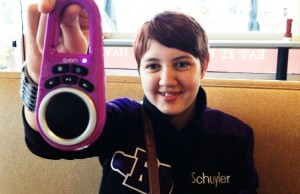The Key
 One of the traps of assistive technology can be the impulse to equate the newest and most expensive tech as being The Key. We’re all looking for The Key, that breakthrough piece of tech that will open doors to communication and suddenly unlock the hidden potential of our kids. Even last week, as I watched the Apple presentation of the new Apple Watch, all I could think was “Just imagine the potential for this technology for disability-related assistive technology!” Even though when I really thought about it, I couldn’t actually think of anything particularly world-changing. But it’s new and shiny and expensive, and for those of us who deal with technological solutions to disability issues, we are attracted to the shiny things like crows.
One of the traps of assistive technology can be the impulse to equate the newest and most expensive tech as being The Key. We’re all looking for The Key, that breakthrough piece of tech that will open doors to communication and suddenly unlock the hidden potential of our kids. Even last week, as I watched the Apple presentation of the new Apple Watch, all I could think was “Just imagine the potential for this technology for disability-related assistive technology!” Even though when I really thought about it, I couldn’t actually think of anything particularly world-changing. But it’s new and shiny and expensive, and for those of us who deal with technological solutions to disability issues, we are attracted to the shiny things like crows.
It’s funny how often a tech solution presents itself with simplicity and a relatively modest price tag. Some things feel like a win; those solutions feel like a championship win.
Schuyler’s polymicrogyria renders her speech largely unintelligible, even to those of us who are well-versed in Schuylerese, and the older she gets, the more she depends on assistive speech technology to express more comprehensive, independent thought. Her iPad Mini is the perfect platform for this in ways both technological and social, as she explained recently in a piece she wrote for BridgingApps, but it has some limitations, chief among which is the low volume at which the iPad renders her speech.
This might sound like a small thing, but it’s actually kind of a major impediment to kids who may already feel self-conscious about how they communicate and can be reluctant to use their devices as a result. I know that when Schuyler tries to say something and the listener can’t hear her, she balks at repeating herself and is particularly hesitant about showing them what’s on her screen when the environment is simply too loud for her to be heard. You’d be surprised at how often this is the case, even in relatively quiet public places.
There are a number of companies who make iPad cases that amplify sound, but there are problems here, too. They can be expensive, and often they turn the lightweight and elegant iPad into a clunky, unwieldy thing that’s not much different from the dedicated speech devices of old. (“Of old” meaning like two years ago, of course.) Breaking the bank in order to make Schuyler hate her iPad didn’t seem like a step in the right direction.
About a week ago, I had the opportunity to try something a little different, the ION Clipster Bluetooth speaker. It was the subject of an online promotion and was both cheap enough to be worth experimenting with and interesting enough to appeal to Schuyler’s sense of cool. It worked beautifully and was not only loud enough to bring her up to a more than conversational level but also had depth and clarity. It clipped easily to her iPad bag, and it was even available in purple.
So the Clipster met and exceeded our hopes for a simple wireless speaker. Schuyler was thrilled to suddenly be able to project, and we took her out to order dinner to give it a test run. And that’s when a funny thing happened.
At the counter of her favorite local burger place, Schuyler programmed her order into her iPad. When she stepped up, however, there was still too much noise for the girl at the counter to hear her. Typically, this is where Schuyler would either give up or very reluctantly show her iPad to the person.
Instead, Schuyler held her new speaker out to the person and spoke again.
This seems like a small thing, but consider for a moment what that means. Until now, Schuyler’s use of a speech prostheses, like most AAC users, has been an exercise in emulation. Using her old speech device and even her iPad meant having a voice like everyone else, except with nothing but disadvantages. Limited volume, lack of personality, and slow to program. Advances in synthetic voices and features like word prediction have minimized some of those issues, but even so, AAC has always represented an imperfect solution.
The rest of us look at assistive speech technology as a way to give users like Schuyler a voice that functions as close to a natural human voice as possible. But to Schuyler, growing up as she is in a world where the virtual and the actual exist together and the technology is so closely integrated into her daily life, she sees no limitations. In a loud room, we might look for a way to amplify her voice even further. But to Schuyler in that moment, she sees her voice as living in a little purple box. She can hold that box out to you, as she did and has done several times since in similar situations. She could even hand you that box, as she has taken to doing with us over dinner as we all talk. She could give that box to a teacher in a classroom so that she could communicate more privately.
Schuyler’s voice is no longer a thing to squeak out of her iPad in close proximity. It’s a thing that can travel beyond her immediate space. In some ways, Schuyler has found a way, though the simple act of handing a speaker over to a listener or placing outside of her own immediate personal space, to improve upon the natural human voice that she has been denied. And in handing that voice over to another, she creates a strange kind of intimacy, better than a shout. In a loud room, Schuyler can put her voice in your ear. I can’t do that, and I find myself ever so slightly envious.
Later that first night, as we drove around, Schuyler handed me the speaker from the back seat, and I clipped it onto my rear view mirror. Speaking with Schuyler when she’s sitting in the back seat of a car can be difficult, but now suddenly her voice is right in front of us, loud and clear in its inexplicable British accent that she loves so much. She’s become excited about using AAC again, not just out of necessity but with genuine enthusiasm. Because Schuyler found The Key, and it didn’t just give her a voice. It gave her some big ideas.
Note: To support the site we make money on some products, product categories and services that we talk about on this website through affiliate relationships with the merchants in question. We get a small commission on sales of those products.That in no way affects our opinions of those products and services.



Oh I’m so, soooooo happy for Schyler and for you!!!! How marvellous! I simply MUST get this for my son’s iPad. He uses ProLo2go for his voice and you’re right, it’s ridiculously quiet. Yay! How exciting! Thank you for sharing 🙂 happy day!
Has she realized she can hide it in a bush and frighten passersby? It IS almost Halloween… 😉
Yay for Schuyler and her out-of-the-box thinking! ;-D
That’s of great encouragement! What program does Schuyler use on her iPad mini?
She uses PRC’s LAMP Words for Life app, using the same language system, Unity, that she used on her old speech device.
I’m not sure if this would work for everyone else, but good for her, and an idea for others who may be in similar circumstances.